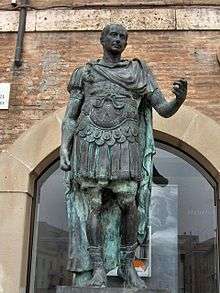Caesarism

.jpg)

Caesarism is a form of political rule that emulates the rule of Roman dictator Julius Caesar over the Roman Republic, in that it is led by a charismatic strongman whose rule is based upon a cult of personality, whose rationale is the need to rule by force, establishing a violent social order, and being a regime involving prominence of the military in the government.[1] It has been used by proponents of it, but it has also been commonly used in a pejorative manner.
A so-called "democratic" form of Caesarism has been advocated by theorists like Venezuela's Laureano Vallenilla Lanz in Cesarismo Democrático (1919).[1]
[2] The most famous person who themselves espoused Caesarism, was Napoleon Bonaparte, who admired and emulated Caesar during his rule in France.[3] Italian Duce Benito Mussolini and the ideology of Italian Fascism espoused Caesarism.[4]
Benjamin Disraeli was also famously accused of Caesarism in March 1878 when, in anticipation of war with Russia, he mobilised British reserves and called Indian troops to Malta. G. K. Chesterton made one of the most ringing denunciations of Caesarism in his work Heretics, calling it "the worst form of slavery".
References
- 1 2 Caesarism, Charisma, and Fate: Historical Sources and Modern Resonances in the Work of Max Weber. Transaction Publishers. 2008. p. 34.
- ↑ von Vacano, Diego A. (2012). The Color of Citizenship: Race, Modernity and Latin American / Hispanic Political Thought. Oxford, UK: Oxford University Press. pp. 83–111. ISBN 9780199746668.
- ↑ Weber, p. 54
- ↑ Emilio Gentile, The Struggle for Modernity: Nationalism, Futurism, and Fascism. Westport, Connecticut: Greenwood Publishers, 2003. pp. 137–138.